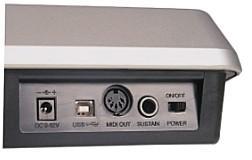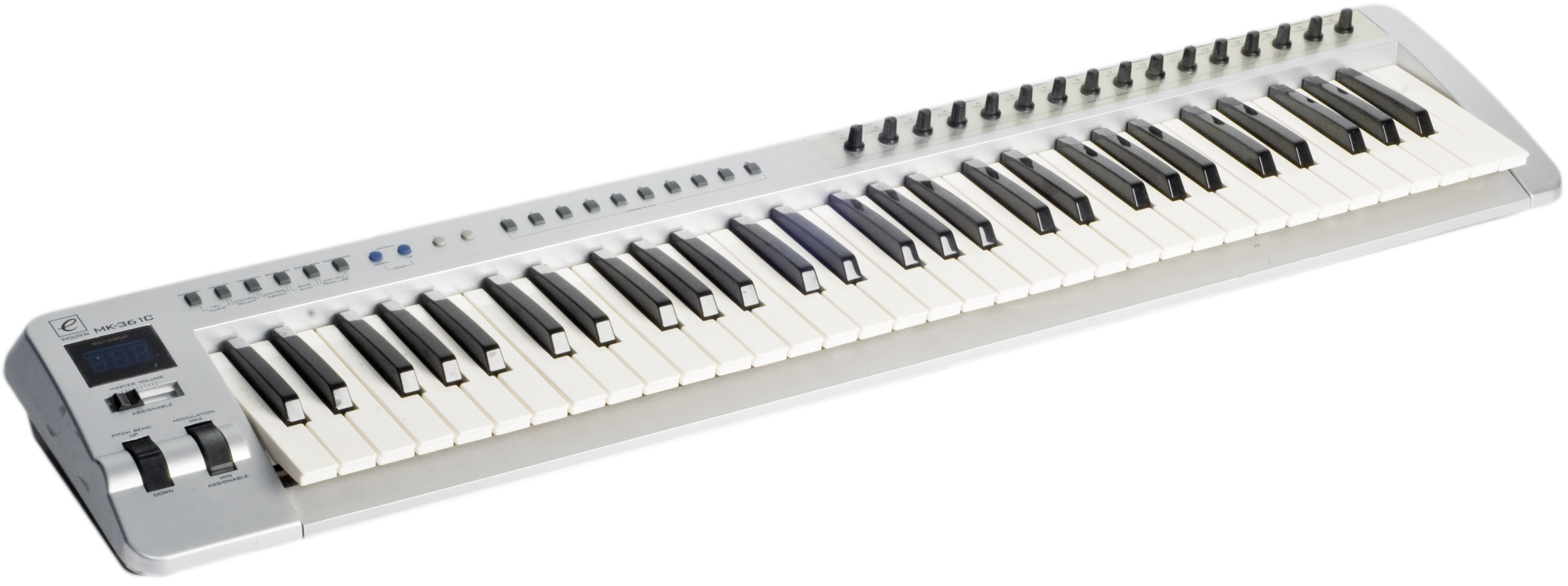OK, it’s time for the first “gear” post. For the most part these will be about a single piece of equipment, sometimes including anecdotes of experiences using it, problems or issues where appropriate, reasons for getting it, and anything else that comes to mind.
Whilst I did use MIDI to hook up my PSS-680 and later PSR-420 to my early computers at a certain point I decided I wanted something “better”. Why? So whilst the PSR-420 had full size keys over the PSS-680 mini keys, it had no pitch bend, which the PSS-680 did have. Neither had a modulation wheel or other “real time” controllers.
Evolution was a company/brand that started with keyboards mainly dedicated for educational usage, but about the time I wanted something for computer sequencing they had a small range of USB controller keyboards, the “flagship” of sorts being their MK-361C.
After researching various options through whatever sources I could (this was in the era of modems for Internet) this keyboard seemed to be a good fit. Firstly, it was a full size 61 key (5 octave) controller keyboard. Secondly, with a depth not much more than the keybed itself it would sit nicely at the front of my computer desk. Thirdly, as well as pitch bend and modulation wheels it had a volume control and 16 rotary encoders for parameter changing. The fact it took power from USB also appealed.
I won’t comment on any included software basically because I really didn’t pay any attention to it. I believe the bundle was a mix of educational “learn to play” and software where I already had “better” equivalents.
The range also included 49 and 61 note versions without the rotary encoders, and 25 and 49 note versions with 12 rotary controllers.

In terms of connections, apart from the USB-B socket for computer connection there’s a MIDI out socket and a jack socket for a sustain socket. The connection panel also features a jack for an optional (user supplied) power supply and an on/off switch. This is useful because the three digit display on the front is very bright and distracting when you’re not using it.
Anyway this served me very well for many years as my means of playing into the computer or even just playing the amazing Yamaha XG sounds I had at my disposal just for enjoyment. I really did boot up a Windows PC, load up a sequencer, and set up a track in an empty project just to play music some days.
In hindsight I didn’t use the rotary encoders nearly as much as I thought, and I’ll come back to these later.
The keys have what I might describe now as a heavy synth action. Some of the heaviness may be down to the age (I’ve probably had this roughly 20 years, give or take a couple) or just I’m now used to lighter less firm keyboards now, but hooking it up again a few weeks ago (after being unused for a couple of years or so) to my current Mac mini music computer it just felt like there was more resistance.
When I’d had the keyboard only a handful of years, and after Evolution had I think been taken over by M-Audio, I got a hell of a scare.
This one day, whenever I played a key or touch a control strange things were happening, with all sorts of MIDI control/parameter changes happening. It was really bizarre and I thought then I would need to replace it, so I spent a few days researching, and trying to decide what to get as a replacement.
I’m not sure now what lead to it, but just as I’d almost convinced myself of what I’d buy to replace my MK-361C, for some reason I was pressing all the buttons and controls, and pressed the channel button. Now usually I left it on channel one, but on pressing the channel button the display showed some huge number way out of the one to sixteen range defined by MIDI. I looked in disbelief, thinking “even that isn’t working and it must be showing some other parameter”. I may have waited past the short time it gives to change parameter, in which case I would have pressed the channel button again, but with this huge channel number flashing I pressed the ‘1’ button and let it accept that parameter.
Hey presto everything was back to normal. I was so happy.
My hypothesis is that somehow by chance the MIDI channel value became corrupted somehow, and possibly due to a bug or oversight the firmware never catered for this, so for key down events this huge channel number was only being added to the MIDI event number (and not range checked) turning key presses into other events. The huge number could also have tripped up other parts of the code. In any case setting the MIDI channel back fixed things.
Potentiometers need exercise
Or at least, certain potentiometers need to be used to really work properly.
How many times have you turned a volume control on something and had the volume level drop out, come back, and generally have noise as you turn it? Over time certain potentiometers can let in very fine dust/grime or more commonly start to oxidise, tarnish or corrode slightly. On volume controls this results in noise as you turn it, on controls used for digital controls this can cause spurious values, sometimes lots of them.
What I’ve found is if a control hasn’t been used in a while (see above for how long I’ve had this controller) as soon as it is touched you’re highly liable to get a stream of spurious values even when you then leave the control alone.
There are “contact cleaners” that can be used if you can directly access the potentiometers, but a simple trick that commonly works is to “exercise” the controls across their entire range of travel a couple of dozen times, which “scrapes” the wiper contact across its track and results in a (temporarily) clean signal with no jittery values. On this keyboard with 16 rotary pots and a linear pot for volume this is time consuming.
In hindsight I should’ve perhaps gone with the 61 key version without the rotary control as, quite frankly, I’ve barely used them, and now I’m either super careful not to touch them, or spend probably five minutes exercising them to make sure they don’t cause any spurious MIDI messages.
Usage without a computer
At a local pub jamming evening I really enjoyed watching a handful of people play. One day far fewer people were there, one of them setting up then disappearing. I knew them fairly well, and a few other people had played his guitar, so picked up this guitar wondering if I could remember this really cheating way of played 12-bar blues. The amp was off but after a minute or two remembered, and just then the person returned. I went to take off the guitar but all he did was turn his amp on and disappear. The next 10 minutes or so had me playing 12-bar blues rhythm, along with a drummer and a guy improvising over the top, before the guitar owner came back and played with “proper” chords. At the end we chatted and was invited to join in. I said keyboard was my real instrument and was told “well bring that”. I didn’t really have anything suitable so I quickly and cheaply worked to get something not needing a computer.
I had a V-Synth XT by this point (more on this in a future post), and I had my Evolution MK-361C which had a rarely used MIDI output and figured with a few extra bits I could cheaply see if I enjoyed playing/jamming live.
I bought a small Kensington branded “USB battery”. At the time the envisioned use was recharging a mobile phone or MP3 player without a mains outlet. I guessed this could power my MK-361C without me needing to find a suitable power adapter or taking a computer along. This worked better than I could’ve imagined, and could power the keyboard for hours upon hours.
I used this controller for a number of months both at home and once a week at a local pub in the evening, only ever putting it basically unprotected in my car when transporting it to and from the pub.
Amazingly everything is still in working order and nothing broken if a little discoloured in places, either due to age, grime, dust, or rogue yellow spray paint.
Current alternatives?
There are so many alternatives to this aged controller these days. I’ll stick to brands I know, though I don’t necessarily know the products.
The spiritual successor would be M-Audio’s Keystation 61. Moving up their ranges the Oxygen 61 is a little deeper, filling the space with controls for performance, but doesn’t include 5-pin DIN MIDI. Further still they have the Code 61 with even more controls.
Alesis have their V61 and VI61 which look the part, the V61 again not having DIN MIDI only USB. I’m not sure I’d like the VI61 having the pitch and modulation controls “above” the keyboard area.
Behringer have a keyboard that really reminds me of my MK-361C in the form of their U-Control UMX610. At least it reminds me because of the rotary controls, a bit because of the shape and the inclusion of DIN MIDI out, not so much because Behringer have chosen a rather bold looking red colour.
Beyond these are controllers from brands I most know from software instruments, Arturia and Native Instruments.
Arturia’s KeyLab Essential 61 looks great from a control point of view, all the connections I’d want but does have the (to me) odd pitch wheel position.
The brand new (not out at time of writing?) Native Instruments Complete Control S61 is plain nuts with colour graphic screens to help interact with their and other software instrument products. Also because of that it lives in the dangerous “it would be so cool to have that” space in my brain as when I work “in the box” I do have NI’s “Komplete” on hand amongst other things.
If I had to “replace” my MK-361C I think the M-Audio Keystation 61 and Behringer U-Control UMX610 would be top of my shortlist.
